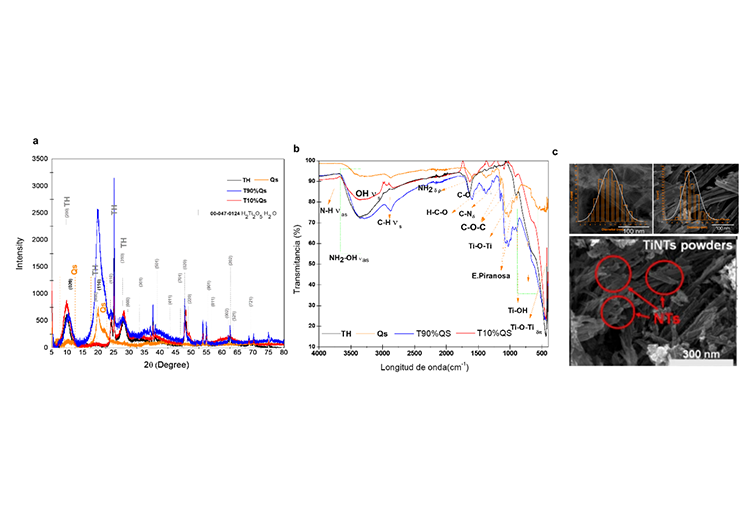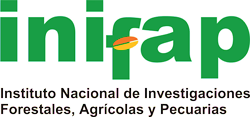Biostimulant effect of nanoparticles of hydrogen titanate with chitosan in Frailescano beans
DOI:
https://doi.org/10.29312/remexca.v16i30.4049Keywords:
Phaseolus vulgaris L., chlorophyll, hydrogen titanates, modern agriculture, nanomaterials, plant stimulationAbstract
The excessive use of fertilizers and agrochemicals in agriculture has caused environmental deterioration. In this context, nanotechnology emerges as a sustainable alternative to modern agriculture. The purpose of this study was to evaluate the biostimulant effect of compounds formed by nanoparticles of hydrogen titanates and chitosan biopolymer, in formulations with 10 and 90% chitosan in the crop of beans (Phaseolus vulgaris L.), Frailescano variety, under greenhouse conditions. The research was carried out in a greenhouse of the Polytechnic University of Chiapas in 2024. The experimental design used was randomized complete blocks with five treatments: T1 (control), hydrogen titanate, chitosan, HT10CS (hydrogen titanate-10% chitosan), and HT90CS (hydrogen titanate-90% chitosan). The study revealed that treatments with hydrogen titanate and HT10CS significantly improved crop yield, increasing the number of pods, leaves, and flower buds. Regarding the content of chlorophyll (cα and cβ) and β-carotenoids, there was an increase due to the application of nanoparticles. This study demonstrates that using titanate and chitosan nanomaterials has the potential to positively impact the development of bean crops, showing a significant effect on key variables of growth and chlorophyll content. This approach allowed for the development of innovative strategies that improve agricultural productivity and reduce environmental impact.
Downloads
References
Arora, S.; Murmu, G.; Mukherjee, K.; Saha, S. and Maity, D. 2022. A comprehensive overview of nanotechnology in sustainable agriculture. Journal of Biotechnology. 355:21-41. https://doi.org/10.1016/j.jbiotec.2022.06.007.
Abdel-Maksoud, M. I. A.; Bekhit, M.; Sherif, D. M.; Sofy, A. R. and Sofy, M. R. 2022. Gamma radiation-induced synthesis of a novel chitosan/silver/Mn-Mg ferrite nanocomposite and its impact on cadmium accumulation and translocation in brassica plant growth. Países Bajos. International Journal of Biological Macromolecules. 194:306-316. https://doi.org/10.1016/j.ijbiomac.2021.11.197.
Ahmed, K. B. M.; Khan, M. M. A.; Siddiqui, H. and Jahan, A. 2020. Chitosan and its oligosaccharides, a promising option for sustainable crop production a review. Carbohydrate Polymers. 227:115331. https://doi.org/10.1016/j.carbpol.2019.115331.
Benavides-Mendoza, A.; González-Moscoso, M.; Ojeda-Barrios, D. L. and Fuentes-Lara, L. O. 2021. Biostimulation and toxicity: two levels of action of nanomaterials in plants. Nanotechnology in Plant Growth Promotion and Protection: recent Advances and Impacts. 283-303 pp. https://doi.org/10.1002/9781119745884.ch14.
Bernardes, M. F. F.; Pazin, M.; Pereira, L. C. and Dorta, D. J. 2015. Impact of pesticides on environmental and human health. Toxicology studies-cells, drugs and environment. 195-233 pp.
Castillo, P. C. H. D.; Castro-Velázquez, V. and Rodríguez-González, V. 2023. Adsorption and photocatalytic-conjugated activity of a chitosan-functionalized titanate coating for the removal of the drug clonazepam from drinking water. Alemania. Environmental Science and Pollution Research. 32:10553-10568. https://doi.org/10.1007/s11356-023-30215-2.
Castro-Velázquez, V.; Hernández-Castillo, P. C.; Díaz-Cervantes, E. and Rodríguez-González, V. 2025. Unraveling the role of chitosan in enhancing the photodegradation of ciprofloxacin by using chitosan-titanates composites: experimental and in-silico approach. Journal of Environmental Management. 375:124265. https://doi.org/10.1016/j.jenvman.2025.124265.
Ebrahimi, A.; Galavi, M.; Ramroudi, M. and Moaveni, P. 2016. Effect of TiO2 nanoparticles on antioxidant enzymes activity and biochemical biomarkers in pinto bean (Phaseolus vulgaris L.). Journal of Molecular Biology Research. 6(1):58-66. http://dx.doi.org/10.5539/jmbr.v6n1p58.
Farahi, M. S. M.; Yazdi, T. M. E.; Einafshar, E.; Akhondi, M.; Ebadi, M.; Azimipour, S.; Mahmoodzadeh, H. and Iranbakhsh, A. 2023. The effects of titanium dioxide (TiO2) nanoparticles on physiological, biochemical, and antioxidant properties of Vitex plant (Vitexagnus castus L.). Heliyon. 9(11):e22144. https://doi.org/10.1016/j.heliyon.2023.e22144.
Francis, D.V.; Abdalla, A. K.; Mahakham, A.; Sarmah, A. K. and Zhmed, A. F. R. 2024. Interaction of plants and metal nanoparticles: exploring their molecular mechanisms for sustainability. agriculture and crop improvement. Environment International. 190:108859. https://doi.org/10.1016/j.envint.2024.108859.
Gohari, G.; Mohammadi, A.; Akbari, A.; Panahirad, S.; Dadpour, M. R.; Fotopoulos, V. and Kimura, S. 2020. Titanium dioxide nanoparticles (TiO2 NPs) promote growth and ameliorate salinity stress effects on essential oil profile and biochemical attributes of Dracocephalum moldavica. Scientific Reports. 10:912. https://doi.org/10.1038/s41598-020-57794-1.
Hassan, E. O.; Shoala, T.; Attia, A. M. F.; Badr, O. A. M.; Mahmoud, S. Y. M.; Farrag, E. S. H. and El-Fiki, I. A. I. 2022. Chitosan and nano-chitosan for management of Harpophora maydis: approaches for investigating antifungal activity, pathogenicity, maize-resistant lines, and molecular diagnosis of plant infection. Journal of Fungi. 8(5):509. https://doi.org/10.3390/jof8050509.
INEGI, 2024. Compendio de Información Geográfica Municipal 2010. Sistema Nacional de Información Estadística y Geográfica. https://www.inegi.org.mx/app/mapa/espacioydatos/default.aspx?ag=07086.
Ithape, D.; Dalvi, S. and Srivastava, A. K. 2024. Chitosan-thiourea and their derivatives: applications and action mechanisms for imparting drought tolerance. Journal of Plant Physiology. 303:154365. https://doi.org/10.1016/j.jplph.2024.154365.
Jeyaraman, M. and Eltzov, E. 2025. Development of the alginate-gelatin-based biosensor for quick B. subtilis detection in foods. Talanta. 288:127739. https://doi.org/10.1016/j.talanta.2025.127739.
Jie, R.; Wu, H.; Yichao, E.; Ye, W.; Xiangpei, K. and Yin, K. 2024. Small particles, big effects: how nanoparticles can enhance plant growth in favorable and harsh conditions. Journal of Integrative Plant Biology. 66:1274-1294. https://doi.org/10.1111/jipb.13652.
Khairy, A. M.; Tohamy, M. R. A.; Zayed, M. A.; Mahmoud, S. F.; El-Tahan, A. M.; El-Saadony, M. T. and Mesiha, P. K. 2022. Eco-friendly application of nano-chitosan for controlling potato and tomato bacterial wilt. Saudi Journal of Biological Sciences. 29(4):2199-2209. https://doi.org/10.1016/j.sjbs.2021.11.041.
Khan, S.; Wang, A.; Liu, J.; Khan, I.; Sadiq, S.; Khan, A. and Bououdina, M. 2024. Bio-inspired green nanomaterials for tomato plant cultivation: An innovative approach of green nanotechnology in agriculture. Países Bajos. Chemical Engineering Journal Advances. 20:100677. https://doi.org/10.1016/j.ceja.2024.100677.
Kumari, K.; Rani, N. and Hooda, V. 2024. Unravelling the effects of nano SiO₂, nano TiO₂ and their nanocomposites on Zea mays L. growth and soil health. Reino Unido. Scientific Reports. 14(1):13996. https://doi.org/10.1038/s41598-024-61456-x.
Lian, J.; Zhao, L.; Wu, J.; Xiong, H.; Bao, Y.; Zeb, A.; Tang, J. and Liu, W. 2020. Foliar spray of TiO₂ nanoparticles prevails over root application in reducing Cd accumulation and mitigating Cd-induced phytotoxicity in maize (Zea mays L.). Chemosphere. 239:124794. https://doi.org/10.1016/j.chemosphere.2019.124794.
Li, P.; Xia, Y.; Song, K. and Liu, D. 2024. The impact of nanomaterials on photosynthesis and antioxidant mechanisms in gramineae plants: research progress and future prospects. Plants. 13(7):984. https://doi.org/10.3390/plants13070984.
Liu, G.; Yang, D.; Zhu, Y.; Ma, J.; Nie, M. and Jiang, Z. 2011. Titanate nanotubes-embedded chitosan nanocomposite membranes with high isopropanol dehydration performance. Reino Unido. Chemical Engineering Science. 66(18):4221-4228. https://doi.org/10.1016/j.ces.2011.06.005https://doi.org/10.1016/j.ces.2011.06.005.
Manimegalai, S.; Vickram, S.; Deena, S. R.; Rohini, K.; Thanigaivel, S.; Manikandan, S.; Subbaiya, R.; Karmegam, N.; Kim, W. and Govarthanan, M. 2023. Carbon-based nanomaterial intervention and efficient removal of various contaminants from effluents. A review. Chemosphere. 312(1):137319. https://doi.org/10.1016/j.chemosphere.2022.137319.
Morales-Santos, M. E.; Peña-Valdivia, C. B.; García-Esteva, A.; Aguilar-Benítez, G. y Kohashi-Shibata, J. 2017. Características físicas y de germinación en semillas y plántulas de frijol (Phaseolus vulgaris L.) silvestre, domesticado y su progenie. Agrociencia. 51(1):43-62.
Medina-Pérez, G.; Fernández-Luqueño, F.; Trejo-Téllez, L. I.; López-Valdez, F. and Pampillón-González, L. 2018. Growth and development of common bean (Phaseolus vulgaris L.) var. Pinto Saltillo exposed to iron, titanium, and zinc oxide nanoparticles in an agricultural soil. Appl. Ecol. Environ. Res. 16(2):1883-1897. https://doi.org/10.15666/aeer/1602-18831897.
Machanuru, R.; Shrivastava, M.; Singh, R.; Singh, B.; Chakraborty, D.; Ramalingappa, P. L. and Narayan, M. 2024. Plant enzymatic activity as an indicator of nano-TiO2 exposure in rice ecosystems, Plant Nano Biology. 10:100117. https://doi.org/10.1016/j.plana.2024.100117.
Ramírez-Rodríguez, S. C.; Preciado-Rangel, P.; Cabrera-Fuente, M.; González-Morales, S. and Ortega-Ortiz. H. 2024. Chitosan nanoparticles as biostimulant in lettuce (Lactuca sativa L.) plants, phyton-international journal of experimental botany. 93(4):777-787. https://doi.org/10.32604/phyton.2024.048096.
Sangerman-Jarquín, D. M.; Acosta-Gallego, J. A.; Schwenstesius-Rindermann, R.; Damián-Huato, M. Á. y Larqué-Saavedra, B. S. 2010. Consideraciones e importancia social en torno al cultivo del frijol en el centro de México. Revista Mexicana de Ciencias Agrícolas.1(3):363-380.
Senthamizh, R.; Vishwakarma, P.; Sinharoy, A.; Sinha, R.; Sharma, S. and Mal, J. 2025. Biogenic nanoparticles and their application in crop protection against abiotic stress: A new dimension in agri-nanotechnology. The Science of the Total Environment. 958:177884. https://doi.org/10.1016/j.scitotenv.2024.177884.
Tudi, M.; Daniel Ruan, H.; Wang, L.; Lyu, J.; Sadler, R.; Connell, D.; Chu, C. and Phung, D. T. 2021. Agriculture development, pesticide application and its impact on the environment. International journal of environmental research and public health. 18(3):1112. https://doi.org/10.3390/ijerph18031112.
Trela-Makowej, A.; Orzechowska, A. and Szymańskav, R. 2024. Less is more: The hormetic effect of titanium dioxide nanoparticles on plants. Science of the total environment. 910:168669. https://doi.org/10.1016/j.scitotenv.2023.168669.
Tripathi, D.; Singh, M. and Pandey-Rai, S. 2022. Crosstalk of nanoparticles and phytohormones regulate plant growth and metabolism under abiotic and biotic stress. Plant Stress. 6:100107. https://doi.org/10.1016/j.stress.2022.100107.
Vázquez-Herrera, P. y Taboada-Gaytán, O. R. 2023. El almacenamiento prolongado afecta la calidad nutricional y el tiempo de cocción del frijol ayocote. México. Revista Mexicana de Ciencias Agrícolas. 14(29):e3542. https://doi.org/10.29312/remexca.v14i29.3542.
Wang, X.; He, M.; Wang, X.; Liu, S.; Luo, L.; Zeng, Q.; Wu, Y.; Zeng, Y.; Yang, Z.; Sheng, G.; Ren, P.; Ouyang, H. and Jia, R. 2024. Emerging nanochitosan for sustainable agriculture. Suiza. International Journal of Molecular Sciences. 25(22):12261. https://doi.org/10.3390/ijms252212261.
Xinyi, L.; Muhammed, N. and Yukui, R. 2024. Effects of nanofertilizers on the mechanism of photosynthetic efficiency in plants: a review. Phyton-International Journal of Experimental Botany. 93(12):3197-3216. https://doi.org/10.32604/phyton.2024.059281.
Zayed, M. M.; Elkafafi, S. H.; Zedan, A. M. and Dawoud, S. F. M. 2017. Effect of nano chitosan on growth, physiological and biochemical parameters of Phaseolus vulgaris under salt stress. Egypt. Journal of Plant Production. 8(5):577-585. Doi. 10.21608/jpp.2017.40468.

Published
How to Cite
Issue
Section
License
Copyright (c) 2025 Revista Mexicana de Ciencias Agrícolas

This work is licensed under a Creative Commons Attribution-NonCommercial 4.0 International License.
The authors who publish in Revista Mexicana de Ciencias Agrícolas accept the following conditions:
In accordance with copyright laws, Revista Mexicana de Ciencias Agrícolas recognizes and respects the authors’ moral right and ownership of property rights which will be transferred to the journal for dissemination in open access. Invariably, all the authors have to sign a letter of transfer of property rights and of originality of the article to Instituto Nacional de Investigaciones Forestales, Agrícolas y Pecuarias (INIFAP) [National Institute of Forestry, Agricultural and Livestock Research]. The author(s) must pay a fee for the reception of articles before proceeding to editorial review.
All the texts published by Revista Mexicana de Ciencias Agrícolas —with no exception— are distributed under a Creative Commons License Attribution-NonCommercial 4.0 International (CC BY-NC 4.0), which allows third parties to use the publication as long as the work’s authorship and its first publication in this journal are mentioned.
The author(s) can enter into independent and additional contractual agreements for the nonexclusive distribution of the version of the article published in Revista Mexicana de Ciencias Agrícolas (for example include it into an institutional repository or publish it in a book) as long as it is clearly and explicitly indicated that the work was published for the first time in Revista Mexicana de Ciencias Agrícolas.
For all the above, the authors shall send the Letter-transfer of Property Rights for the first publication duly filled in and signed by the author(s). This form must be sent as a PDF file to: revista_atm@yahoo.com.mx; cienciasagricola@inifap.gob.mx; remexca2017@gmail.
This work is licensed under a Creative Commons Attribution-Noncommercial 4.0 International license.


